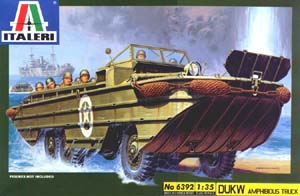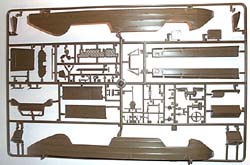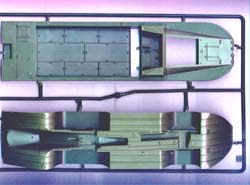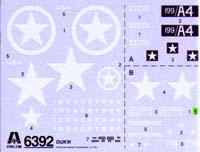| ITALERI 1/35 DUKW-353
AMPHIBIOUS TRUCK KIT No. 6392
MSRP: $35.00 |  | HISTORY The DUKW was an amphibious U.S. vehicle. It was more familiarly known as the "DUCK". This was an amphibian version of the standard U.S. Army "deuce-and-a-half" 2 1/2-ton truck. The name came from the official nomenclature of DUKW-353, a combination of letters indicating amphibian, cargo, 6 x 6 wheel arrangement, and 2 1/2-ton payload. The vehicle was designed and developed by the National Defence Research Committee in answer to a directive issued by the Commanding General, Service and Supply, U.S. Army, to the Quartermaster Corps in 1942. The design was basically a watertight hull to which the mechanical components of the 2 1/2-ton GMC truck were attached. For operation on land the normal 6-wheel drive functioned, with conventional steering of the front wheels. Once in water, the drive to the wheels was disconnected and a screw propeller brought into use. Steering in water was done by the combined action of the normally steered front wheels and a rudder at the stern end which was linked to the steering column. The hull was decked over in front of the driving compartment, providing cover for the engine and bilge pump, while the rear of the hull was formed into an open cargo compartment which could carry 25 fully equipped soldiers or 2368 kg (5000 lbs) of cargo. One in every four vehicles was provided with a ring-type machine-gun mount alongside the driver, over the passenger seat, with a .50 calibre machine-gun (this is not provided in the kit). This was mainly intended for anti-aircraft protection. Apart from this the only other armament would be the driver's and passenger's personal weapons. Some vehicles were also fitted with a crane. This was because all cargo had to be lifted into and out of the cargo area, either by raw arm power or the crane. Manufacture was undertaken by the Yellow Truck and Coach Manufacturing Division of General Motors, and the production figures ran into several thousand. They were widely used throughout the war by U.S. and Allied troops in every theatre. Their principal purpose being to ferry supplies and ammunitions from ships, across landing beaches, direct to forward supply dumps and fighting units. They also proved invaluable in river crossings and in moving men and supplies forward across flooded area of northwest Europe in 1944-45. They remained in service for several years after WWII, being used in the Korean War, but in the late 1950s they were replaced by various tracked amphibian cargo carriers and none are now left in military service. Tech Data: Weight: Combat loaded 8876kg (19,568 lbs)
Length: 9.45m (31 ft.)
Width: 2.51m (8 ft. 3 in.)
Height: 2.16m (7 ft. 1 in.)
Crew: 2
Armament: 1 x 0.5-in. (.50 cal) machine-gun on every 4th vehicle.
Powerplant: GMC 270 6-cylinder gasoline, 269 cu. in. (4417 cc), 104 bhp at 2740 rpm
Speed: 72 km/h (45 mph) land, 10 km/h (6.2 mph) water.
Range: 350 km (220 miles) land, 80 km (50 miles) water. WHAT'S IN THE BOX?: The kit comes in a lid and tray type box. The box art shows a DUKW coming ashore, leading a second DUKW, and loaded with soldiers. (unfortunately, there are NO figures provided in the kit). A transport ship looms in the background and a water spout is erupting beside the lead DUKW. It is obvious that the DUKW's are under artillery fire. Three photos of the finished model adorn a side panel of the box. The kit contains three olive drab colored trees of parts, a tree of clear parts, (I wish Italeri had cello bagged these clear parts to prevent scratching), the decal sheet, and the instructions.  The largest tree, letter "A", holds the vehicle's hull sides, windshield frame, floor screen, dashboard, steering wheel, steering column, anchor, headlight guards, rear-view mirrors, engine compartment door, engine compartment fire wall (NO engine is provided...boo hoo), cargo compartment walls, bilge pump, head light housings, front surf plate and its support arms, tail lights and their guards, driver and passenger seats, propeller and its shaft, control levers, winch, winch cable hook, and the rudder (52 parts). The largest tree, letter "A", holds the vehicle's hull sides, windshield frame, floor screen, dashboard, steering wheel, steering column, anchor, headlight guards, rear-view mirrors, engine compartment door, engine compartment fire wall (NO engine is provided...boo hoo), cargo compartment walls, bilge pump, head light housings, front surf plate and its support arms, tail lights and their guards, driver and passenger seats, propeller and its shaft, control levers, winch, winch cable hook, and the rudder (52 parts).  Tree letter "B" just holds two parts...the bottom and top of the hull only. This vehicle's body goes together similar to building a armor kit from Eastern Europe, where you assemble a box from its four sides. Tree letter "B" just holds two parts...the bottom and top of the hull only. This vehicle's body goes together similar to building a armor kit from Eastern Europe, where you assemble a box from its four sides. Letter "C" tree holds the wheels, (including one spare) axles, boat hook pole, rope hull bumpers, jerry cans, leaf springs and their supports, tie downs, brake drums, axle end caps, drive shafts, sway bar, axe, shovel, etc. (82 parts)  The clear parts, letter "D" tree, holds the headlight lenses, windshield and fly window glass. (6 parts) The clear parts, letter "D" tree, holds the headlight lenses, windshield and fly window glass. (6 parts) The decal sheet and the instructions complete the kit's contents. The Instructions are a large sheet that telescopes out into 10 pages. Page one gives us the history of the DUKW in 8 languages including English. Page two begins with paragraphs of general assembly instructions, this time in 11 languages. The middle of the page has missing parts request coupons in six languages, to mail into Italeri if you find a part missing in your kit. The bottom of the page gives us color reference alphabet letters, used throughout the assembly drawings. It recommends Model Master paints along with FS numbers for the colors. Page 3 starts with parts tree drawings. The bottom of the page gives us the first assembly step drawings. Pages 4 through 8 give us the balance of assembly steps, which total 14 in all. The bottom of page 8 gives decal application instructions in 9 languages.  Page 9 has three paint scheme drawings: Page 9 has three paint scheme drawings: 1. U.S. Army, Normandy 1944
2. U.S. Army, Germany 1945
3. U.S. Marines, Iwo Jima 1945 These schemes are all fairly plain, but markings on DUKW's were usually non-spectacular. Page 10 gives us hazard warnings in no less than 20 languages. The surf splash guard, mounted on the bow of the DUKW, is designed to be positioned only in the UP position in the kit. However, by eliminating the support arms, it could be modeled as flat..or in the stowed position...which it would be when on land. Parts are crisply molded and injector pin marks are all pretty much where they will never be seen once the kit is assembled (nice move Italeri). Conclusion A cargo load is definately in order to add to this kit. There are several cargo load kits produced by various model companies that will fill this bill. Figures are needed too. Italeri could have...at least...provided a driver figure...sigh. But, again...there are TONS of figures of GIs available elsewhere to add. Since the DUKW carried such a wide variety of equipment you are only limited by your imagination as to what to add to the cargo area. This kit subject has long been awaited by armor modelers and will be very welcome to many display shelves. Highly recommended. I purchased this kit at my local shop. | 







|

 The largest tree, letter "A", holds the vehicle's hull sides, windshield frame, floor screen, dashboard, steering wheel, steering column, anchor, headlight guards, rear-view mirrors, engine compartment door, engine compartment fire wall (NO engine is provided...boo hoo), cargo compartment walls, bilge pump, head light housings, front surf plate and its support arms, tail lights and their guards, driver and passenger seats, propeller and its shaft, control levers, winch, winch cable hook, and the rudder (52 parts).
The largest tree, letter "A", holds the vehicle's hull sides, windshield frame, floor screen, dashboard, steering wheel, steering column, anchor, headlight guards, rear-view mirrors, engine compartment door, engine compartment fire wall (NO engine is provided...boo hoo), cargo compartment walls, bilge pump, head light housings, front surf plate and its support arms, tail lights and their guards, driver and passenger seats, propeller and its shaft, control levers, winch, winch cable hook, and the rudder (52 parts). Tree letter "B" just holds two parts...the bottom and top of the hull only. This vehicle's body goes together similar to building a armor kit from Eastern Europe, where you assemble a box from its four sides.
Tree letter "B" just holds two parts...the bottom and top of the hull only. This vehicle's body goes together similar to building a armor kit from Eastern Europe, where you assemble a box from its four sides.  The clear parts, letter "D" tree, holds the headlight lenses, windshield and fly window glass. (6 parts)
The clear parts, letter "D" tree, holds the headlight lenses, windshield and fly window glass. (6 parts)  Page 9 has three paint scheme drawings:
Page 9 has three paint scheme drawings:






